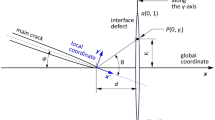Abstract
Intra-ply or inter-ply slippages are commonly seen at the crack tip impinging upon an interface in laminated anisotropic bodies. An interface slippage could occur in the form of yielding (e.g., a well-bonded ductile layer with plastic yielding) or debonding (e.g., a weak, sliding-free one) along the interface direction. This paper presents a fundamental solution for a crack in one individual brittle part impinging normally upon the interface slippage with the neighboring brittle part of laminated anisotropic materials under tensile loading. A superposition method is employed to explicitly solve the problem which combines the solution of a crack in a perfectly bonded elastic homogeneous medium, the solution of a continuous distribution of dislocations which represent slippage at the interface and an appendix solution which offsets the stress on the crack faces induced by the dislocations. This procedure reduces the problem to a singular integral equation which can be numerically solved by using Chebyshev polynomials. The validity of the present solutions is numerically verified where the traction-free condition on the crack faces and the equilibrium of shear stress along the interface slippage can be really satisfied. Numerical implementations are performed to analyze the influence of interface slippage on cracking and stress redistribution in laminated anisotropic bodies. It is found that interface yielding or interface debonding redistributes the stress ahead of the crack tip in the neighboring uncracked part. The presence of interface yielding or debonding lowers the high stress concentration in the tensile stresses ahead of the crack tip. It is also concluded that interface debonding appears to be more effective in lowering the stress concentration than interface plastic yielding.






Similar content being viewed by others
References
He, M.Y., Heredia, F.E., Wissuchek, D.J., Shaw, M.C., Evans, A.G.: The mechanics of crack growth in layered materials. Acta Metall. Mater. 41(4), 1223–1228 (1993)
Dalgleish, B.J., Trumble, K.P., Evans, A.G.: The strength and fracture of alumina bonded with aluminum alloys. Acta Metall. Mater. 37(7), 1923–1931 (1989)
Chartier, T., Merle, D., Besson, J.L.: Laminar ceramic composites. J. Eur. Ceram. Soc. 15(2), 101–107 (1995)
Gotsis, P.K., Chamis, C.C., Minnetyan, L.: Application of progressive fracture analysis for predicting failure envelopes and stress–strain behaviors of composite laminates: a comparison with experimental results. Compos. Sci. Technol. 62(12–13), 1545–1559 (2002)
Folsom, C.A., Zok, F.W., Lange, F.F., Marshall, D.B.: Mechanical behavior of a laminar ceramic/fiber-reinforced epoxy composite. J. Am. Ceram. Soc. 75(11), 2969–2975 (1992)
Hutchinson, J.W., Suo, Z.: Mixed mode cracking in layered materials. Adv. Appl. Mech. 29, 63–191 (1991)
Beuth Jr, J.L.: Cracking of thin bonded films in residual tension. Int. J. Solids Struct. 29(13), 1657–1675 (1992)
Dauskardt, R.H., Lane, M., Ma, Q., Krishna, N.: Adhesion and debonding of multi-layer thin film structures. Eng. Fract. Mech. 61(1), 141–162 (1998)
Aveston, J., Cooper, G.A., Kelly, A.: Single and multiple fracture, the properties of fiber composites[C]. In: Conference proceedings on properties of fiber composites, pp. 15–26. National Physical Laboratory. IPC Science and Technology Press Ltd, Guildford, UK (1971)
Budiansky, B., Hutchinson, J.W.: Matrix fracture in fiber-reinforced ceramics. J. Mech. Phys. Solids 34(2), 167–189 (1986)
Chiang, Y.C.: The influence of Poisson contraction on matrix cracking stress in fiber reinforced ceramics. J. Mater. Sci. 36(13), 3239–3246 (2001)
Solti, J.P., Mall, S., Robertson, D.D.: Modeling damage in unidirectional ceramic-matrix composites. Compos. Sci. Technol. 54(1), 55–66 (1995)
Sih, G.C., Paris, P.C., Irwin, G.R.: On cracks in rectilinearly anisotropic bodies. Int. J. Fract. Mech. 1(3), 189–203 (1965)
Lekhnitskii, S.G., Tsai, S.W., Cheron, T.: Anisotropic Plates. Gordon and Breach Science Publishers, London (1968)
Kortschot, M.T., Beaumont, P.W.R.: Damage mechanics of composite materials: I—measurements of damage and strength. Compos. Sci. Technol. 39(4), 289–301 (1990)
Chan, K.S., He, M.Y., Hutchinson, J.W.: Cracking and stress redistribution in ceramic layered composites. Mater. Sci. Eng. 167(1–2), 57–64 (1993)
Dollar, A., Steif, P.S.: A tension crack impinging upon frictional interfaces. J. Appl. Mech. 56(2), 291–298 (1989)
Lo, K.K.: Analysis of branched cracks. J. Appl. Mech. 45(4), 797 (1978)
Muskhelishvili, N.L.: Some Basic Problems of Mathematical Theory of Elasticity. Noordhoff International Publishing, Leiden (1958)
England, A.M.: Complex Variable Methods in Elasticity. Wiley Intersciencem, New York (1971)
Erdogan, F., Gupta, G.D.: On the numerical solution of singular integral equations. Q. Appl. Math. 28(6), 525–534 (1972)
Erdelyi, A., Bateman, H.: Higher Transcendental Functions, vol. 2. McGraw-Hill, New York (1953)
Lam, K.Y., Cleary, M.P.: Slippage and re-initiation of (hydraulic) fractures at frictional interfaces. Int. J. Numer. Anal. Methods 8(6), 589–600 (1984)
Gale, J.F.W., Laubach, S.E., Olson, J.E., Eichhubl, P., Fall, A.: Natural fractures in shale: a review and new observations. AAPG Bull 98(11), 2165–2216 (2014)
Acknowledgments
This work was supported by the National Natural Science Foundation of China with Grant Nos. 11472205, 11202156, 11321062, 11242015 and 11172228, 11172228 and 11572235 and the Fundamental Research Funds for the Central Universities in China.
Author information
Authors and Affiliations
Corresponding author
Rights and permissions
About this article
Cite this article
Hou, J., Li, Q., Liu, G. et al. Fundamental solutions of a crack impinging upon an interface slippage in laminated anisotropic bodies. Arch Appl Mech 86, 687–700 (2016). https://doi.org/10.1007/s00419-015-1055-y
Received:
Accepted:
Published:
Issue Date:
DOI: https://doi.org/10.1007/s00419-015-1055-y




